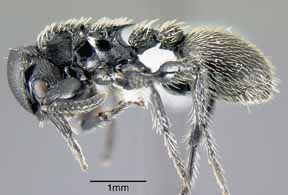

Formicidae, Hymenoptera, Insecta, Arthropoda, Animalia
|
|
|
Image catalogue, worker (click here).
Image catalogue, worker, sem (click here).
Range
Costa Rica, Panama.
Description of worker
Worker measurements (n=1, Costa Rica): HW 1.499, HL 1.405, SL 0.805, EL 0.354, MeL 1.611, MeW 1.078, PrW 0.770, PrL 0.476, PrS 0.225, PrT 0.702, MTL 0.961, MFL 1.011, MFW 0.394, PtL 0.462, PtW 0.425, PpW 0.569, PtH 0.415, AL 1.672, AW 1.4751.
Head subcircular, tending to triangular; vertex concave, strongly differentiated from face by vertex margin, which is entire and coarsely crenate; face evenly convex; clypeus little differentiated from face, curving ventrad but not sharply so, following general curve of face in lateral view; anteromedian portion of clypeus slightly impressed, with a discrete tuft of golden setae; frontal carina thickened and laterally flattened just posterior to torulus, ending on dorsum of torulus; vertex completely smooth and shining, or with 2-3 obscure rugae medially; face very shallowly sculptured with a mixture of somewhat irregularly distributed, large foveae (these reminiscent of lunar craters) and fine, irregular, longitudinal rugae, rugae stronger near occipital border; interspaces very finely and superficially microareolate; sculpture on clypeus similar to that on face, but with foveae more obscure; genae and mandibles coarsely longitudinally striate; scapes with a flanged skirt at base, partially covering neck and condyle; base of scape above skirt subterete, expanding distally to a broad, flat apex; scape finely and superficially microareolate, like interspaces of face.
Promesonotum in dorsal view with rounded anterior margin, straight to somewhat convex sides which converge to base of propodeum; in lateral view, mesonotum slopes throughout entire length to deep propodeal suture; lateral lobes of mesonotum in the form of horizontal flanges which are blunt, posteriorly-directed, and project over the propodeal suture, such that in side view their vertically concave posteroventral margins obscure the median portion of the suture; dorsal face of propodeum with produced lateral lobes which extend about half the length of the dorsal face; posterior border of lobes subrectangular, tooth-like, to gently rounded; propodeal spines about 0.4x length of dorsal face; posterior face of propodeum perpendicular to dorsal face, concave, and completely smooth and shining; entire dorsal surface of mesosoma longitudinally striate; sides of pronotum flat to concave, meeting dorsal face at distinct angle; lateral face with coarse longitudinal striae on lower half, extending onto anepisternum, and onto metapleural region of propodeum; rest of side smooth and shining, superficially, finely microareolate; femora very strongly swollen, spindle-shaped; forefemur compressed, flattened; exterior surfaces of tibiae coarsely rugose; distal half of posterior face of forefemur weakly rugose, rest of legs smooth and shining.
Petiole short and squat, anterior face completely smooth and shining, posterior face and dorsum of postpetiole longitudinally striate, but striae nearly effaced by dense, coarse, piligerous puncta; first gastral tergite longitudinally striate throughout, striae slightly irregular, occasionally anastomosing; interspaces microareolate, giving a subopaque or granular appearance to gaster; longitudinal striae on second gastral tergite variably developed; first gastral sternite subopaque to somewhat shiny, with microareolate sculpture becoming denser near lateral margins; lateral margins with a few faint rugulae.
Setae very dense and conspicuous; setae present on legs, mandibles, scapes, lateral and posterior margins of face (absent on disc), entire mesosomal dorsum, petiole, postpetiole, and gaster; setae all stiff, those on dorsal surfaces strongly flattened (although always linear, never spatulate), suberect to decumbent; those on first gastral tergite dense enough to obscure the underlying sculpture; setae which lie on the same longitudinal line on first gastral tergite overlap up to half their length; setae on first gastral sternite abundant, subdecumbent, thinner than those on dorsum; integument entirely black, setae yellowish-white.
Description of queen:
Queen measurements (n=1, Costa Rica, barcode: LACM ENT 141585): HW 1.641, HL 1.563, SL 0.834, EL 0.429, MeL 2.147, MeW 1.307, MTL 1.097, MFL 1.147, MFW 0.415, PtL 0.593, PtW 0.480, PpW 0.650, PtH 0.472, AL 2.004, AW 1.661, ASW 0.030.
Similar to worker in most respects; face uniformly, sparsely foveate, foveae small, interspaces 2x or more fovea diameter, interspaces with microareolate sculpture; no interspersed rugae (in contrast to the workers, which have a mixture of foveae and faint rugae); pronotum foveate laterally, each fovea with stiff, flattened seta, pronotum smooth medially with a few small foveae; mesoscutum, axillae, and scutellum with a mixture of foveae and longitudinal striae; relatively sparse setae on mesoscutum, axillae, and scutellum; dorsal face of propodeum longitudinally striate.
Natural History
This species inhabits primary rainforest, where workers are encountered on low vegetation and in treefalls. In Costa Rica, it is sympatric with the very similar P. paleatus and P. tortuguero.
Types and Synonymy
Procryptocerus puncticeps race impressus Forel, 1899:47-8. Lectotype worker, paralectotype queen: Panama, Bugaba (Champion) [BMNH].
Procryptocerus subpilosus impressus: Forel, 1911:263; Kempf, 1951:63.
Procryptocerus subpilosus (F. Smith) (part): Kempf, 1964a:435-436 (incorrectly synonymized under P. subpilosus).
Procryptocerus impressus Forel: Longino and Snelling 2002.
Page author:
John T. Longino, The Evergreen State College, Olympia WA 98505 USA. longinoj@evergreen.edu
Date of this version: 6 December 2002.